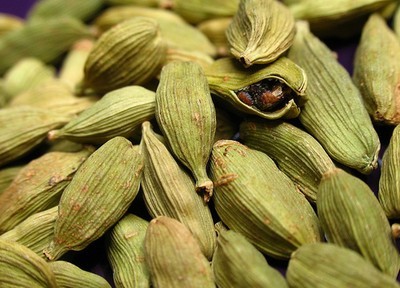
Common Name: Choti Elaichi, Elaa,
English Name: Cardamom fruit, Lesser cardamom
Botanical name: Elettaria cardamomum Maton.
Family: Zingiberaceae
Description: This is a herbaceous perennial plant as is referred as queen of spices. It is found commonly in southern India mainly in Kerala, Tamilnadu and Karnataka, on the shady slopes of the western Ghats. Today, Cardamom is also cultivated in Nepal, Sri Lanka, Guatemala, Mexico, Thailand and Central America. This bushy herb will grow to a height of 6 to10 feet with erect shoots from a thick, underground rootstock. The shoots bear two rows of dark green leaves each about 2 inches long. The leaves are long, alternate and lance-shaped.
Chemical Constitution: The main chemical components of cardamom oil are a-pinene, b-pinene, sabinene, myrcene, a-phellandrene, limonene, 1,8-cineole, y-terpinene, p-cymene, terpinolene, linalool, linalyl acetate, terpinen-4-oil, a-terpineol, a-terpineol acetate, citronellol, nerol, geraniol, methyl eugenol and trans-nerolidol.
Properties: Used internally for indigestion, nausea, vomiting and pulmonary disease with copious phlegm It can be used to prevent stomach pain, griping, as well as flatulence. Cardamom seeds are chewed to sweeten the breath and to detoxify caffeine, in people taking excessive amounts of coffee.The oil made from cardamom seeds is very good for digestive system. It relieves colic, wind, dyspepsia and nausea. It also works to warm the stomach and helps with heart burn. In South Asia, green cardamom is extensively used to treat infections in teeth and gums. It is also used to prevent throat troubles, congestion of the lungs.
Used in the following MATXIN products: